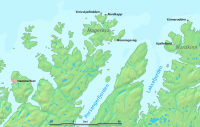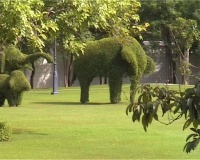Difference between revisions of "Chapter 74: 717-732"
Greenlantern (Talk | contribs) (→Page 722) |
Greenlantern (Talk | contribs) (→Page 722) |
||
| Line 95: | Line 95: | ||
'''Mr. Halfpenny's ''Rural Architecture in the Chinese Taste'''''<br> | '''Mr. Halfpenny's ''Rural Architecture in the Chinese Taste'''''<br> | ||
William Halfpenny, English 18th-century architectural designer; he described himself as "architect and carpenter". His books deal almost entirely with domestic architecture, and especially with country houses in the neo-Gothic and Chinoiserie fashions which were so greatly in vogue in the middle of the 18th century. His most important publications, from the point of view of their effect upon taste, were ''New Designs for Chinese Temples, in four parts'' (1750-52); ''Rural Architecture in the Gothic Taste'' (1752); ''Chinese and Gothic Architecture Properly Ornamented'' (1752); and ''Rural Architecture in the Chinese Taste'' (1750-1752). This last book is believed to have introduced the word "gazebo" to the English language. From [http://en.wikipedia.org/wiki/William_Halfpenny WIKI] | William Halfpenny, English 18th-century architectural designer; he described himself as "architect and carpenter". His books deal almost entirely with domestic architecture, and especially with country houses in the neo-Gothic and Chinoiserie fashions which were so greatly in vogue in the middle of the 18th century. His most important publications, from the point of view of their effect upon taste, were ''New Designs for Chinese Temples, in four parts'' (1750-52); ''Rural Architecture in the Gothic Taste'' (1752); ''Chinese and Gothic Architecture Properly Ornamented'' (1752); and ''Rural Architecture in the Chinese Taste'' (1750-1752). This last book is believed to have introduced the word "gazebo" to the English language. From [http://en.wikipedia.org/wiki/William_Halfpenny WIKI] | ||
| + | |||
| + | '''Peat Baths'''<br> | ||
| + | A peat pulp bath is a bath prepared of peat pulp from wetlands. Balneotherapy in form of peat pulp baths is offered in many health resorts. From [http://en.wikipedia.org/wiki/Peat_pulp_bath WIKI] | ||
==Annotations Index== | ==Annotations Index== | ||
{{MD PbP}} | {{MD PbP}} | ||
Revision as of 15:36, 9 November 2009
Page 717
North CapeNorth Cape (Norwegian: Nordkapp) is a cape on the island of Magerøya in northern Norway, in the municipality of Nordkapp. Its 307 m high, steep cliff is often referred to as the northernmost point of Europe, located at 71°10′21″N 25°47′40″E / 71.1725°N 25.79444°E / 71.1725; 25.79444, 2102.3 km from the North Pole. However, the neighbouring point Knivskjellodden is actually 1,457 metres further north. Moreover, both of these points are situated on an island, which means the northernmost point of mainland Europe is in fact Cape Nordkinn (Kinnarodden), about 20 km from the village of Mehamn. From WIKI
Cherry Island
Cherry Island is the only island in Loch Ness, Highland, Scotland, and is an example of a crannog. The island is about 150 yards (140 m) from the shore near the southern end of the loch... A castle stood on the island during the 15th century; this was constructed of stone and oak wood and was probably used as a fortified refuge. It has been suggested that Cherry Island may have been a hunting lodge, with Dog Island the home for the hunting dogs. From WIKI
pro forma
The term pro forma (Latin "as a matter of form") is a term applied to practices that are perfunctory, or seek to satisfy the minimum requirements or to conform to a convention or doctrine. From WIKI
Page 718
Boswell
James Boswell, 9th Laird of Auchinleck (October 29, 1740 - May 19, 1795) was a lawyer, diarist, and author born in Edinburgh, Scotland; he is best known for his biography of Samuel Johnson. His name has passed into the English language as a term (Boswell, Boswellian, Boswellism) for a constant companion and observer. From WIKI
Nitre, for Gunpowder
Nitre is the mineral form of potassium nitrate, KNO3, also known as saltpeter (US) or saltpetre (UK). Historically, the term "nitre" – cognate with "natrium", a Latin word for sodium – has been very vaguely defined, and it has been applied to a variety of other minerals and chemical compounds, including sodium nitrate (also "soda nitre" or "cubic nitre"), sodium carbonate and potassium carbonate. From WIKI
Page 719
crepuscular
See page 465.
Scows
A scow, in the original sense, is a flat bottomed boat with a blunt bow, often used to haul garbage or similar bulk freight; cf. barge. The etymology of the word is from the Dutch schouwe, meaning such a boat. From WIKI
Ulster
Ulster is one of the four Provinces of Ireland, located in the north of the island. Ulster is composed of nine counties: Antrim, Armagh, Down, Fermanagh, Londonderry, and Tyrone are part of Northern Ireland; while Cavan, Donegal, and Monaghan are part of the Republic of Ireland. From WIKI - Also, see page 572.
Page 720
hypnagogickally
See page 338.
"Sandwich"
See pages 366-367.
Donegal
Donegal is a town in County Donegal, in the Province of Ulster, in Ireland. Donegal is not the county town (capital) of County Donegal, despite being its namesake, however until the early 17th century it was the capital of the larger former Kingdom and Principality of Tyrconnell... Donegal town is situated at the mouth of Donegal Bay, on the River Eske and is overshadowed by the Bluestack Mountains. The Irish name translates into English as Fort of the Foreigners (Vikings). From WIKI
Munchausen
See page 350.
Page 721
'as above, so below'
See page 487.
fluxions
See page 602.
Reverend Dr. Taylor, an Infinite Series
In mathematics, the Taylor series is a representation of a function as an infinite sum of terms calculated from the values of its derivatives at a single point. It is named after the English mathematician Brook Taylor (see page 384). If the series is centered at zero, the series is also called a Maclaurin series, named after the Scottish mathematician Colin Maclaurin. It is common practice to use a finite number of terms of the series to approximate a function. The Taylor series may be regarded as the limit of the Taylor polynomials. From WIKI
Epsilonics... Defective Zero
See page 482.
Imp
An imp is a mythological being similar to a fairy or demon, frequently described in folklore and superstition. The word may perhaps derive from the term ympe, used to denote a young grafted tree. Imps are often described as mischievous more than seriously threatening, and as lesser beings rather than more important supernatural beings. The attendants of the devil are sometimes described as imps. They are usually described as lively and having small stature... Originating from Germanic folklore the imp was a small lesser demon. It should also be noted that unlike the Christian faith and stories, demons in Germanic legends were not necessarily always evil. Imps were often mischievous rather than evil or harmful and in some regions they were attendants of the gods. From WIKI
Kabbala
See page 479.
Oakboys
The Oakboys was a largely non-sectarian agrarian secret society on Ireland. They are also called Greenboys or Hearts of Oak. It was regulatory, concerned with a moral issue as they perceived it. It sprang up in Ulster in mid-1763. Its targets were the County cess, the road-building activities of the Grand Juries which the cess financed, and the perennial grievance of tithes. From WIKI
Dublin Pale
Eventually, after the 16th and 17th centuries, and especially after the Anglican Reformation and the Plantation of Ulster, many of the "Old English" settlers were gradually assimilated into the Irish population, in large part due to their relative reluctance to give up Roman Catholicism (those who worshiped in the Church of Ireland were rewarded with a higher status). They kept their version of the English language, which had Cornish influences, for the most part. They were in fact joined by other English Roman Catholics fleeing persecution under Queen Elizabeth I and subsequent monarchs. By the Tudor period, however, the Irish culture and language had regained most of the territory initially lost to the colonists: even in the Pale ‘all the common folk … for the most part are of Irish birth, Irish habit and of Irish language’. From WIKI
Lord Pennycomequick
See this LINK
Bordeaux
Bordeaux is a port city on the Garonne River in southwest France. It is the capital of the Aquitaine region, as well as the prefecture of the Gironde department. Its inhabitants are called Bordelais. From WIKI
Second Charles
See page 335.
Wag
A witty person. From WIKI
Page 722
Robin Hood
Robin Hood is a hero in English folklore, a highly skilled archer and outlaw. In particular, he is known for "stealing from the rich and giving to the poor," assisted by a group of fellow outlaws known as his "Merry Men". Robin and many of his men wore Lincoln green clothes. From WIKI
Buff
Buff is a pale yellow-brown colour that got its name from the colour of buff leather. From WIKI
the Folly
In architecture, a folly is a building constructed strictly as a decoration, having none of the usual purposes of housing or sheltering associated with a conventional structure. In the 18th century English gardens and French landscape gardening often featured Roman temples, which symbolized classical virtues or ideals. Other 18th century garden follies represented Chinese temples, Egyptian pyramids, ruined abbeys, or Tatar tents, to represent different continents or historical eras. Sometimes they represented rustic villages, mills and cottages, to symbolize rural virtues. "Folly" is used in the sense of fun or light-heartedness, not in the sense of something ill-advised. From WIKI
Topiary is the art of creating sculptures in the medium of clipped trees, shrubs and sub-shrubs. The word derives from the Latin word for an ornamental landscape gardener, topiarius, creator of topia or "places", a Greek word that Romans applied also to fictive indoor landscapes executed in fresco. No doubt the use of a Greek word betokens the art's origins in the Hellenistic world that was influenced by Persia, for neither Classical Greece nor Republican Rome developed any sophisticated tradition of artful pleasure grounds. From WIKI
Obelisks
An obelisk is a tall, narrow, four-sided, tapering monument which ends in a pyramid-like shape at the top. Ancient obelisks were often monolithic. From WIKI
Mr. Halfpenny's Rural Architecture in the Chinese Taste
William Halfpenny, English 18th-century architectural designer; he described himself as "architect and carpenter". His books deal almost entirely with domestic architecture, and especially with country houses in the neo-Gothic and Chinoiserie fashions which were so greatly in vogue in the middle of the 18th century. His most important publications, from the point of view of their effect upon taste, were New Designs for Chinese Temples, in four parts (1750-52); Rural Architecture in the Gothic Taste (1752); Chinese and Gothic Architecture Properly Ornamented (1752); and Rural Architecture in the Chinese Taste (1750-1752). This last book is believed to have introduced the word "gazebo" to the English language. From WIKI
Peat Baths
A peat pulp bath is a bath prepared of peat pulp from wetlands. Balneotherapy in form of peat pulp baths is offered in many health resorts. From WIKI

